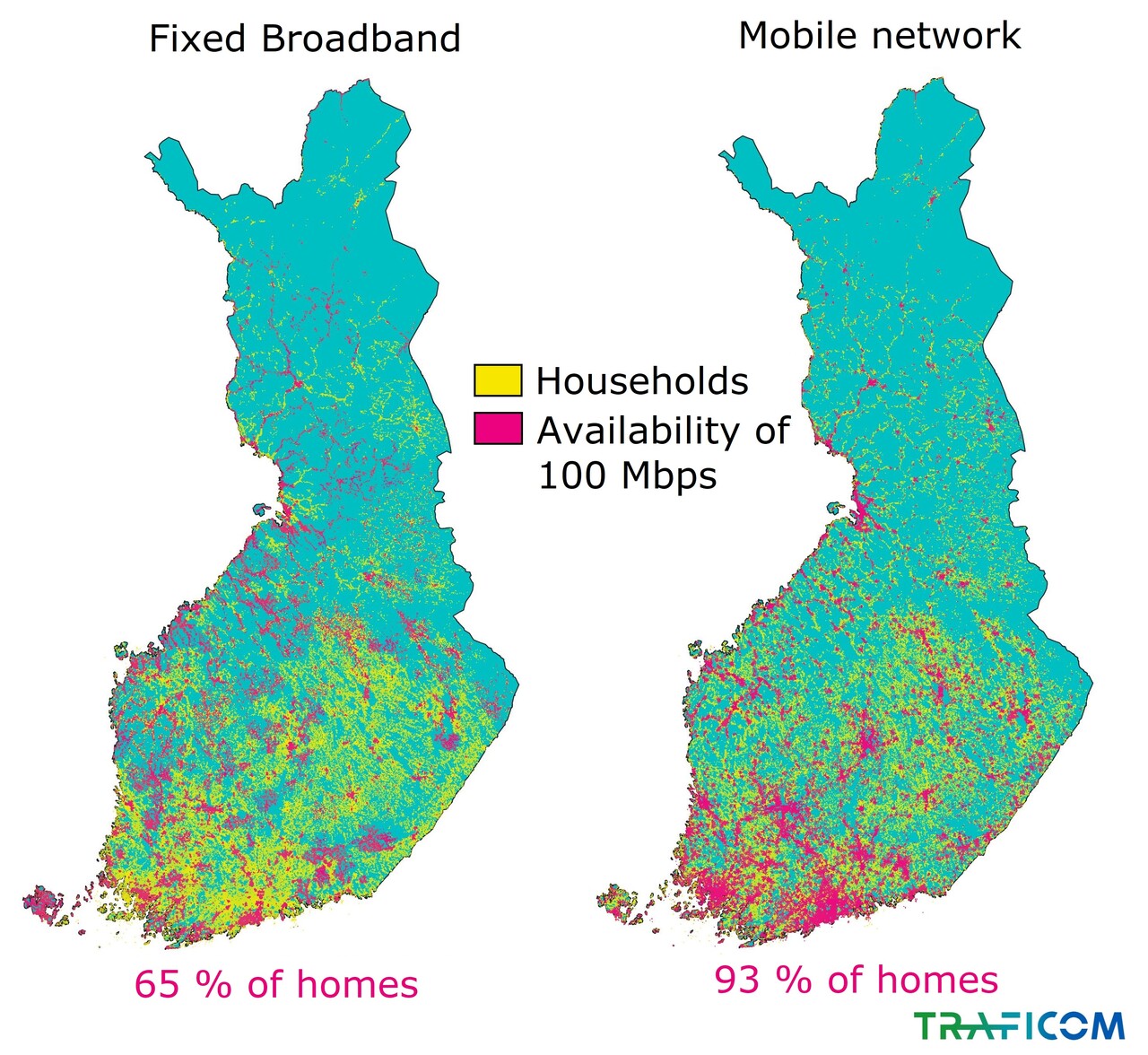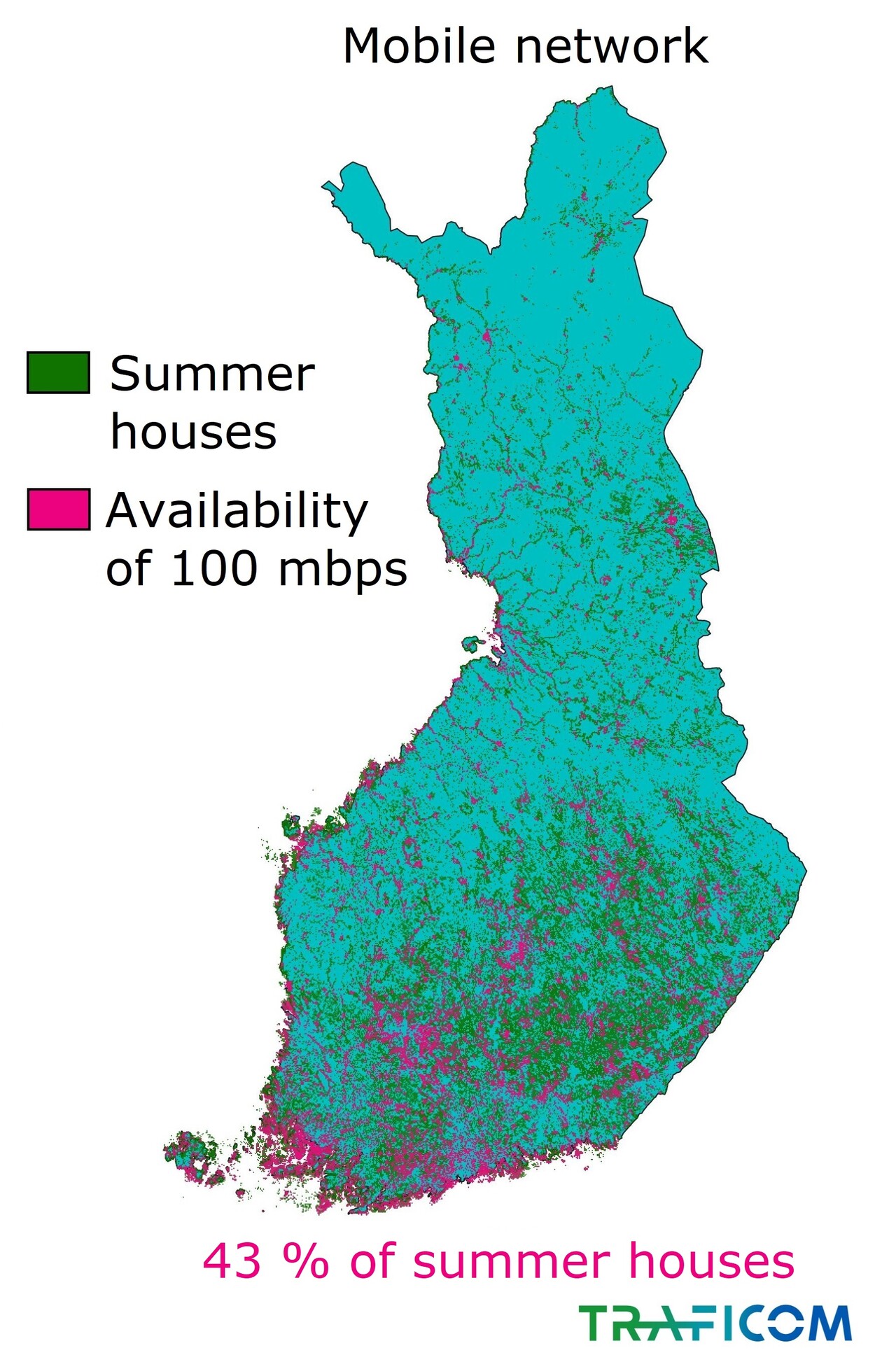According to information collected by Finnish Transportation and Communications Agency (Traficom), a fixed broadband connection with a download speed of 100 Mbit/s or higher was available to 65 percent of Finnish households at the end of 2020. Of summer houses, only a fraction had access to similar broadband connections. In mobile networks, 100 Mbit/s connections were available to 93% of Finnish households – a relatively high figure. For summer houses, the figure is 43%. As telecommunication, telepresence and other online services become more diversified, broadband networks need to respond to growing data transfer requirements in and outside of urban areas.
In spring 2020, 38% of consumers needed a network connection for telecommuting, and 27% for distance learning. Approximately half of the consumers of working age needed a network connection for work at least weekly, many of them probably every day due to the current exceptional circumstances. What kind of network connections are needed for smooth online activities, and what is their availability and prevalence in Finland? Traficom has published a set of communication market statistics that reflect the situation at the end of 2020; these are used to review the current state here.
The use of online services is affected considerably by the connection speed: faster connections load website content quicker and buffer video playback faster, and more than one device can share the connection without problems. “A reliable 100-megabit connection is, generally speaking, very good for most professional tasks and pastime. Some users might even be fine with slower connections. On the other hand, large families may find even fast connections sometimes sluggish if many users share the connection simultaneously", says Senior Specialist Elina Pallas.
Fixed broadband connections are robust and reliable, mobile broadband connections flexible
Fixed broadband connections of 100 Mbit/s and more are usually implemented by using fibre-optic or cable modem connections. Their chief advantage is their reliability: weather, terrain or network congestion rarely have an impact on their operation. Mobile broadband connections are also popular in Finland. The drawback of mobile connections, however, is their lower robustness: the promised connection speeds are only available in ideal situations where the network load in relation to the base station capacity is lower. In actual use, the number of users may exceed the capacity during high-traffic hours, making connections and data transfer slower. The advantage of mobile broadband connections is their mobility. The subscription is not bound to a specific location, but can be taken wherever it is required for business or leisure. Approximately half of Finns have both a fixed broadband connection as well as a mobile one.
At the end of 2020, a fixed broadband connection of 100 Mbit/s or more was available to 1.8 million Finnish households (65%). More than 1.6 million households had a fixed broadband connection. The data transfer speeds of broadband connections have increased steadily as old copper-based networks have been replaced with fibre-optic ones. The download speed of 46% of connections used by households was 100 Mbit/s or more. In the subscription agreements, download speeds are usually higher than upload speeds; 10% of current connections had an upload speed of 100 Mbit/s or more.
Mobile network coverage is relatively high in Finland, and a mobile broadband connection of 100 Mbit/s or more was available in 93% of households. Finnish households had 6.5 million mobile telephone subscriptions with Internet access, a quarter of which were data-only subscriptions for devices such as 4G/5G modems. Of these mobile broadband connections, 58% reached download speeds of 100 Mbit/s at best.
However, the actual speeds often remain below the maximum rates specified in the agreements for the reasons given above. According to the Mobiilimittari connection speed test application developed by VTT, the average download speed reached by the users of mobile broadband connections was 38 Mbit/s in 2020. The transfer rates also tend to vary by the time of day as mobile networks may become congested, especially in the evenings.

Few fast connections for summer houses
Due to the increasing popularity of telecommuting, interest in the network connection options of summer houses is high. Fast (100 Mbit/s) fixed broadband was available in only approximately ten percent of summer houses. Mobile 100 Mbit/s connections were available to 43% of Finnish summer houses, but, in practice, natural obstructions often result in much lower connection speeds. Summer houses are defined here as buildings that are designated as recreational buildings in the building register of the Finnish Digital and Population Data Services Agency and are not used as permanent residences.

High data volumes in the networks of the future
The volume of data transferred online is increasing constantly. In 2020, the data volume transferred through Finnish mobile networks increased by 33%. For fixed networks, no single reliable source for data transfer volume statistics is available yet. The growth of the data volume is not slowing down – on the contrary, it can be expected to increase with 5G innovations and more diverse and complex online services of the future.
According to the global estimate, almost 80% of all data transferred online is video (Cisco). With increasing video resolution and high-definition content required by, for example, emerging virtual reality applications, data transfer volumes can be expected to increase considerably. From the perspective of interactive online services of the future, it can be assumed that the importance of upload speeds will also increase to enable the upstream transfer of high-definition video content from users. As more and more everyday activities go online, and especially in image and video applications, the importance of robust and fast network connections is highlighted.
The information is based on data collected by the Finnish Transport and Communications Agency (Traficom) from telecommunications operators and other sources.
For further information
Fixed broadband availability by region (31 December 2020)
Coverage of mobile broadband services (31 December 2020)
The Monitori service (External link)
Summary table of communication statistics (External link)
Joonas Sotaniemi, Communications Market Specialist, tel. +358 295 390 309, joonas.sotaniemi@traficom.fi
Elina Pallas, Senior Specialist, tel. +358 295 390 126, elina.pallas@traficom.fi